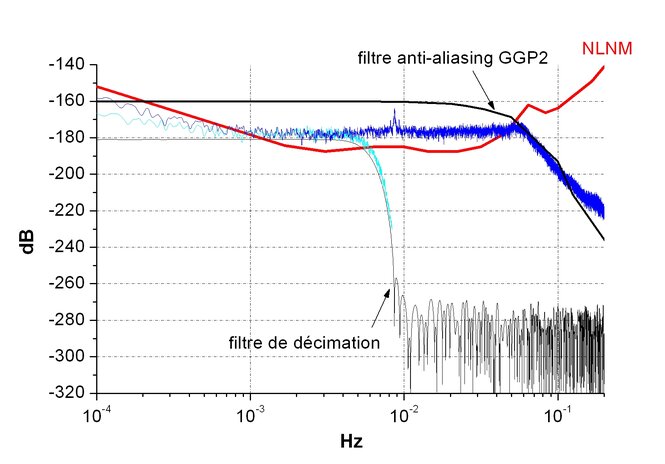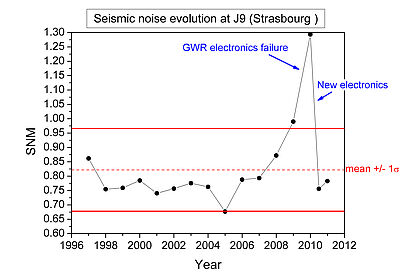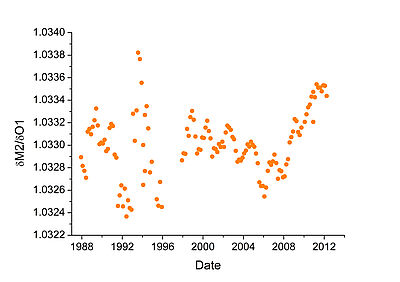Voir aussi
Niveaux de bruit du site SG de Strasbourg par rapport à d'autres stations du réseau GGP
L'analyse en densités spectrales de puissance (PSD) sur la moyenne des 5 jours les plus calmes (absence de séisme) après avoir ôté une marée théorique et l’effet local de la pression atmosphérique via une admittance de -3 nm/s²/hPa permet d'estimer le niveau de bruit de la station gravimétrique de Strasbourg J9 et de la comparer aux autres sites du réseau mondial GGP.

En bleu la PSD sur les données 2 sec et en cyan sur les données 1 minute de Strasbourg (SG GWR C026). Le filtre analogique anti-aliasing GGP2 et le filtre numérique de décimation de 2 sec à 1 min sont représentés. En rouge, le niveau de bruit sismologique de référence (modèle de Peterson : New Low Noise Model) est également représenté. Plus une PSD est élevée, plus le niveau de bruit est élevé.
Evolution du bruit dans la bande sismique à J9
La magnitude bruit sismique SNM (Seismic Noise Magnitude) est définie à partir de la moyenne de la PSD dans une certaine bande de fréquence, selon l'équation : SNM = log10(mean PSD [µGal²/Hz]) + 2.5 (Banka, 1997). Cette magnitude contient moins d'information que la PSD mais permet une comparaison rapide de la qualité d'un site dans la bande sismique. Sur le graphe ci-dessous, la magnitude est calculée dans la bande 340s - 600s afin d'éviter l'effet de l'atténuation du filtre passe-bas utilisé lors de la décimation des données 2s ou 1s à 1 minute. L'évolution année par année du bruit sismique à J9 montre la dégradation obtenue lors d'une défaillance de l'électronique GEP-2 du constructeur en 2010.
Stabilité temporelle des gravimètres supraconducteurs
Temporal variations of the delta factor ratio delta(M2)/delta(O1), derived from the results of the tidal analysis using ETERNA 3.4 software on yearly segments shifted month by month of the merged series of 2 superconducting gravimeters (T005+C026) at J9 station (after Calvo et al. 2014)
The variations of the ratio delta(M2)/delta(O1) are much smaller than the variations for each individual gravimetric factor. Besides this internal SG C026 stability (∼0.1%) as derived from the tidal analyses is more than 10 times better than the one that can be achieved by SG/AG calibration repetitions (∼1.4%). We do not find any correlation between the variations in tidal factors and scale factors. Therefore it is highly possible that the observed time variations of delta factors are due mostly to the noise variations as shown by the correlation found between delta factor deviations and noise level changes.
Quelques publications sur le sujet
- Arnoso, J., U. Riccardi , J. Hinderer , B. Córdoba & ·F. G. Montesinos, 2014. Analysis of co-located measurements made with a LaCoste&Romberg Graviton-EG gravimeter and two superconducting gravimeters at Strasbourg (France) and Yebes (Spain), Acta. Geod. Geophys., DOI 10.1007/s40328-014-0043-y
- Calvo, M., S. Rosat, J. Hinderer, H. Legros and J.-P. Boy, 2013. Study of the time stability of tides using a long term (1973-2011) gravity record at Strasbourg, France, Earth on the Edge: Science for a Sustainable Planet, Proceedings of the IAG General Assembly, Melbourne, Australia, June 28 - July 2, 2011, Series: International Association of Geodesy Symposia, Vol. 139, Rizos, Chris; Willis, Pascal (Eds.), 377-382.
- Calvo, M., Hinderer, J., Rosat, S., Legros, H., Boy, J.-P., Ducarme, B., W. Zürn, 2014. Time stability of spring and superconducting gravimeters through the analysis of very long gravity records, J. of Geodyn., doi:10.1016/j.jog.2014.04.009
- Crossley, D., Hinderer, J., & Riccardi, U., 2013. The measurement of surface gravity, Reports on Progress in Physics 76, 10.1088/0034-4885/76/4/046101
- Riccardi, U., Rosat, S. et Hinderer, J., 2011. Comparison of the Micro-g LaCoste gPhone-054 spring gravimeter and the GWR-C026 superconducting gravimeter in Strasbourg (France) using a 300-day time series, Metrologia, 48, 28-39.
- Riccardi, U., Rosat, S., & Hinderer, J., 2012. On the accuracy of the calibration of superconducting gravimeters using absolute and spring sensors: A critical comparison, Pure and Applied Geophysics, Volume 169, Number 8, 1343-1356 DOI: 10.1007/s00024-011-0398-8
- Rosat, S., et Hinderer, J., 2011. Noise Levels of Superconducting Gravimeters: Updated Comparison and Time Stability, Bull. Seism. Soc. Am., vol. 101, no. 3, June 2011, doi:10.1785/0120100217.
- Rosat, S., Hinderer, J., Crossley, D. et Boy, J.P., Performance of superconducting gravimeters from long-period seismology to tides, J. of Geodyn., 38, 3-5, 461-476, 2004.
- Rosat, S., Hinderer, J., Crossley, D. et Rivera, L., The search for the Slichter Mode: Comparison of Noise Levels of Superconducting Gravimeters and Investigation of a Stacking Method, Phys. Earth Planet. Int., 140, 183-202, 2003
- Rosat, S., Calvo, M., Hinderer, J., Riccardi, U., Arnoso, J. and W. Zürn, 2014. Comparison of the performances of different Spring and Superconducting Gravimeters and a STS-2 Seismometer at the Gravimetric Observatory of Strasbourg, France, Stud. Geophys. Geod., accepted

![<em>Analyse en densités spectrales de puissance (PSD) pour les stations GGP équipées de SG de type Compact [d'après Rosat et Hinderer 2011].</em> Analyse en densités spectrales de puissance (PSD) pour les stations GGP équipées de SG de type Compact [d'après Rosat et Hinderer 2011].](/websites/_processed_/8/d/csm_5daysPSD-Compact_obs_77d6d46a62.jpg)

